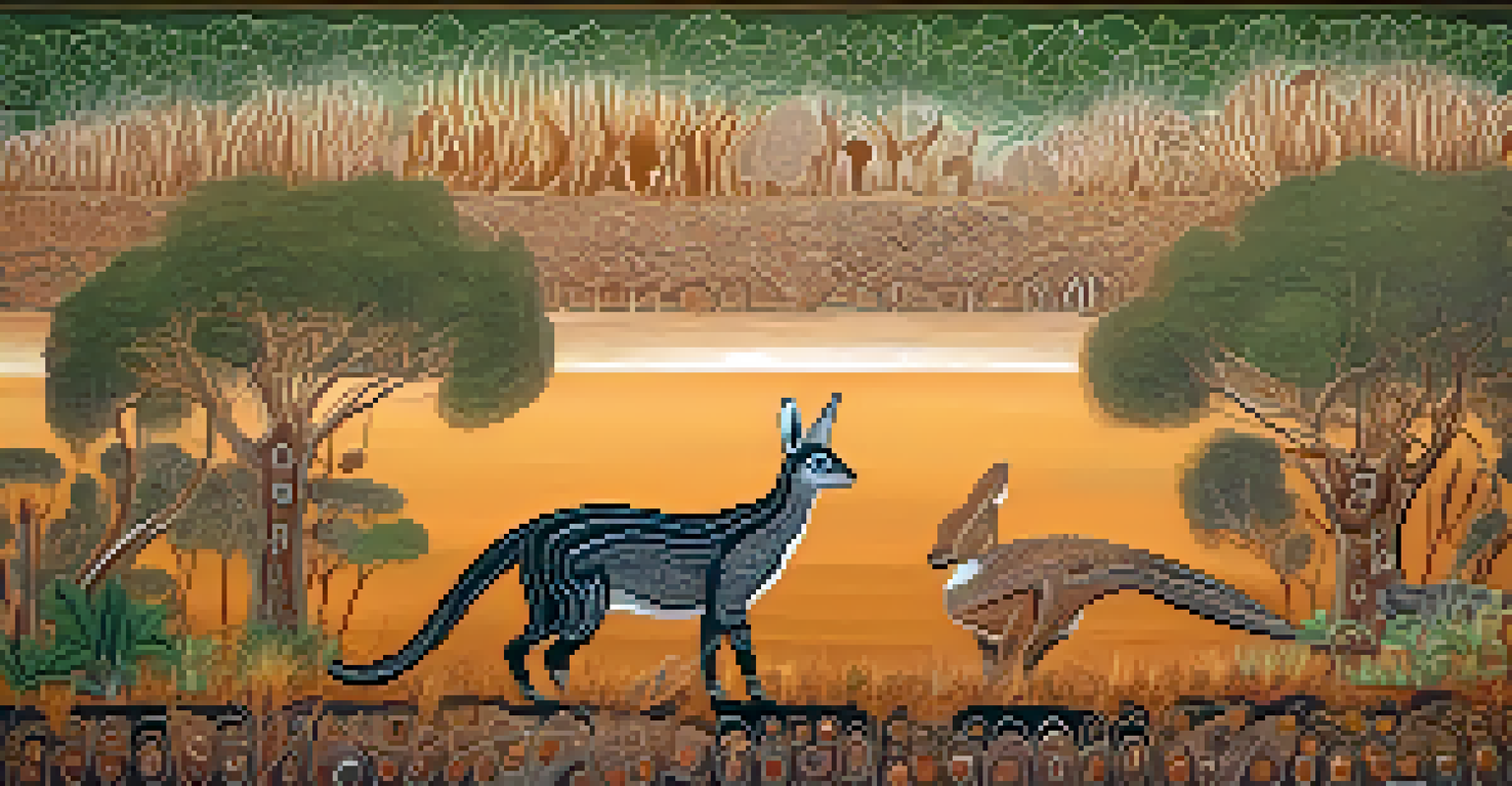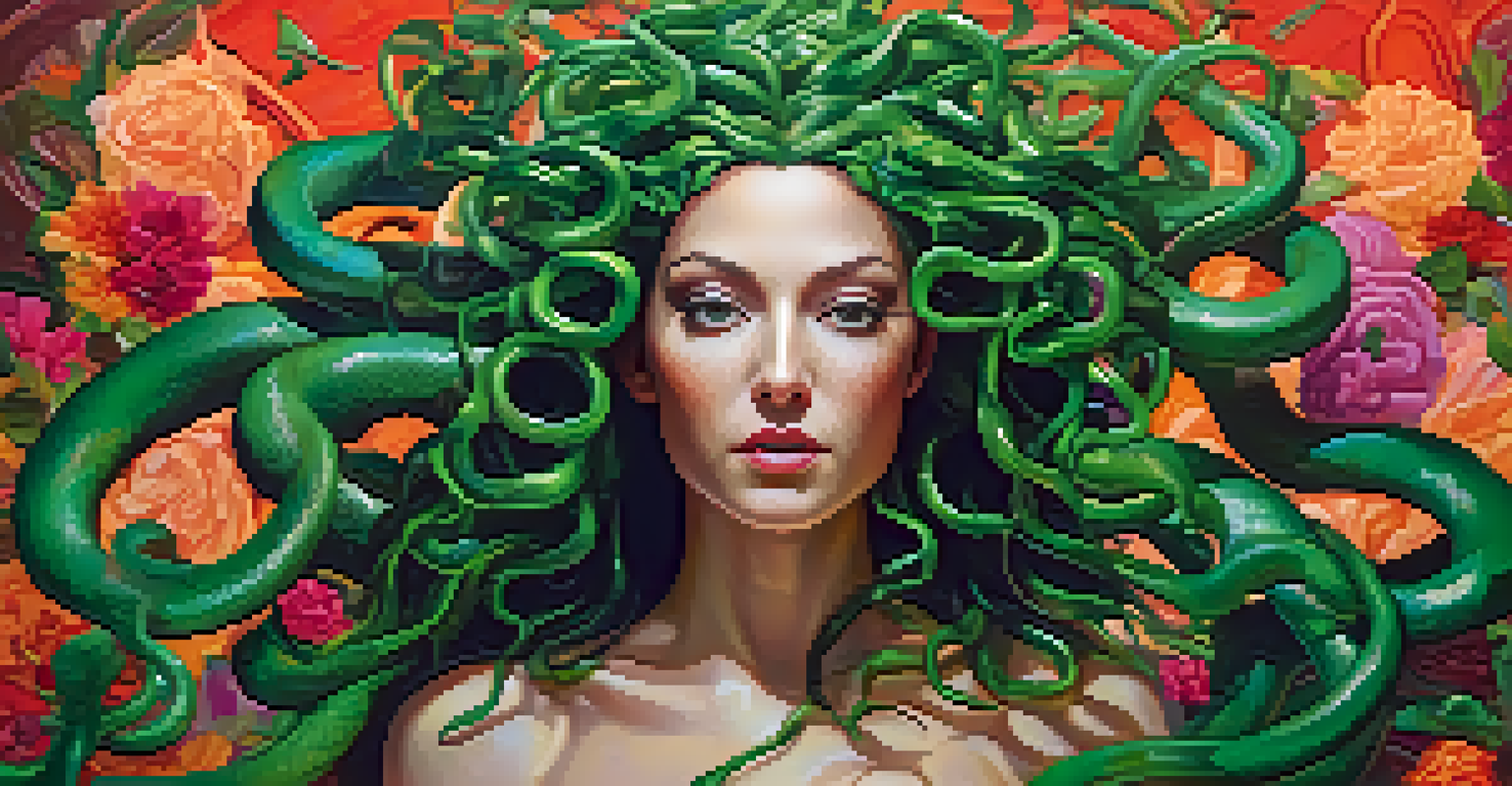Art as a Reflection of Myth: Cultural Perspectives Explored

Understanding the Connection Between Art and Myth
Art and myth have been intertwined since ancient times, shaping cultures and beliefs. Myths often serve as the narrative foundation for artistic expression, providing themes and symbols that resonate deeply within societies. For instance, the myth of Hercules has inspired countless artworks, illustrating the hero's trials and triumphs across various mediums.
Art is the most beautiful of all lies; it is a lie that tells the truth about our deepest fears and desires.
Through art, these myths become tangible, allowing us to explore universal themes such as heroism, love, and the struggle between good and evil. Artists often draw upon these stories to convey complex ideas and emotions, making the abstract more relatable. This interplay creates a rich tapestry where art serves as a vessel for cultural storytelling.
By examining how different cultures interpret similar myths through their art, we can appreciate the diversity in expression and meaning. Each culture brings its unique lens, showcasing how art evolves while remaining rooted in mythological traditions.
Cultural Perspectives: How Different Societies View Myths
Cultural perspectives shape how myths are portrayed in art, reflecting the values and beliefs of a society. For instance, Indigenous Australian art often incorporates Dreamtime stories, which are integral to their identity and connection to the land. These artworks are not just decorative; they serve as a means of preserving history and teaching future generations about their cultural heritage.

In contrast, Western art has historically approached myth with a focus on individualism and heroism, often celebrating figures like Achilles or Odysseus as symbols of human potential. This perspective highlights the tension between personal ambition and communal responsibility, creating a narrative that resonates with the values of Western society.
Art Reflects Cultural Myths
Art serves as a mirror to societal values, showcasing how different cultures interpret and express their myths.
By examining these differences, we can see how art serves as a mirror, reflecting societal values and encouraging dialogue about identity and history. Understanding these cultural nuances enriches our appreciation of art and the myths that inspire it.
Visual Storytelling: Art’s Role in Myth Interpretation
Art functions as a powerful medium for visual storytelling, enabling myths to transcend language and cultural barriers. Through imagery, artists can convey complex narratives, allowing viewers to engage emotionally with the stories. For example, the vibrant murals of ancient Egypt depict the afterlife and gods, inviting viewers into a world where art and spirituality intertwine.
Mythology is not a lie, mythology is poetry, it is metaphorical.
This visual language not only serves to educate but also to provoke thought and inspire imagination. Each brushstroke or carving can evoke feelings and provoke questions about the human experience, making myths accessible to everyone. Artists become storytellers, inviting us to delve deeper into the meanings behind their creations.
As we explore various artistic representations of myths, we begin to understand how different cultures interpret and internalize these tales. This exploration enriches our understanding of humanity, showing us that while the stories may differ, the underlying themes often resonate universally.
The Evolution of Myths in Contemporary Art
Contemporary art continues to evolve, often reinterpreting traditional myths to reflect modern values and issues. Artists today are not only drawing on ancient narratives but also challenging and redefining them. For instance, feminist artists have reimagined myths like Medusa, transforming her from a figure of fear into a symbol of empowerment and resilience.
This evolution highlights how myths can adapt to contemporary contexts, allowing artists to address current social issues while still honoring their origins. By doing so, they create a dialogue between the past and present, encouraging audiences to rethink their understanding of these timeless tales.
Visual Storytelling Engages Emotion
Through visual storytelling, art enables myths to transcend cultural barriers, inviting viewers to connect emotionally with complex narratives.
Furthermore, this reinterpretation invites new generations to engage with mythology in innovative ways. As artists continue to explore and remix these narratives, they contribute to an ongoing conversation about identity, culture, and the role of myth in our lives.
Symbolism in Art: Decoding Mythological Elements
Symbolism plays a crucial role in bridging the gap between myth and art. Artists use symbols to convey deeper meanings, often rooted in mythological themes. For example, the use of the serpent in various cultures can represent transformation, healing, or danger, depending on the context of the artwork.
By decoding these symbols, viewers can gain a richer understanding of the underlying myths and their significance. This process encourages active engagement with art, prompting us to consider not just what we see but what it represents within a broader cultural context.
As we explore the symbolism in art, we uncover layers of meaning that speak to the human experience. This exploration reveals how interconnected our stories are, regardless of time and place, highlighting the universal nature of myths and their artistic representations.
Art as a Cultural Archive: Preserving Myths for Future Generations
Art serves as a cultural archive, preserving myths and stories for future generations. Through various forms of artistic expression, cultures can document their history, beliefs, and traditions, ensuring they are not lost to time. For instance, the intricate tapestries of medieval Europe depicted biblical stories, serving both decorative and educational purposes.
This archival function of art is essential in a rapidly changing world, where globalization can sometimes overshadow local customs and narratives. By capturing the essence of these myths in art, societies can pass down their heritage, fostering a sense of identity and continuity.
Contemporary Art Reinterprets Myths
Contemporary artists remix traditional myths to address modern issues, fostering dialogue between the past and present.
As we appreciate the role of art in preserving myths, we recognize its power to connect us across generations. This connection reinforces the importance of storytelling in maintaining cultural identity, making art not just a reflection but a vital part of our shared human experience.
Conclusion: The Lasting Impact of Myths in Art
In conclusion, the relationship between art and myth is a dynamic and evolving one, reflecting cultural perspectives and societal values. By examining how different cultures interpret and express mythological themes, we gain insight into the diverse ways that art shapes and is shaped by human experience. The stories we tell through art continue to resonate, serving as a bridge between the past and present.
Art allows us to explore these narratives in new and engaging ways, reminding us of the power of storytelling. By continuing to celebrate and reinterpret these myths, we keep them alive, ensuring they remain relevant in our ever-changing world.

Ultimately, the impact of myths in art is profound, offering us a deeper understanding of ourselves and our shared humanity. As we engage with these artistic expressions, we become part of a larger conversation about culture, identity, and the enduring power of myth.